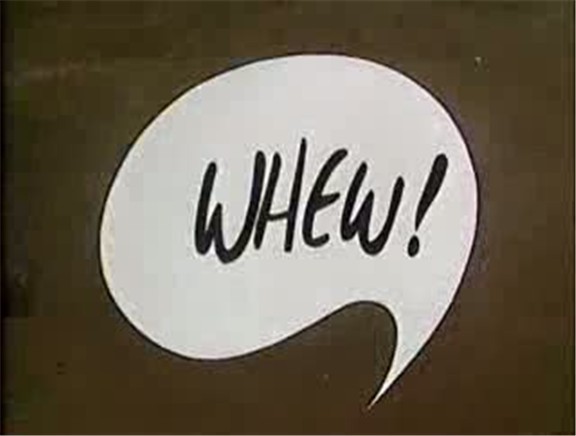Close calls! Naaaaaarrow escapes!
Split-second decisions! And $25,000 in cash! A combination guaranteed to
make you say...

SHOW: WHEW!
AIR DATES: April 23, 1979 to May 30, 1980
CREATOR: Jay Wolpert
HOST: Tom Kennedy
WATCH IT AT: youtu.be/_MH-v4tQRsI
As stated before, Jay Wolpert was a relative genius at making unique
and fun game shows...though few of them lasted. After the original
"Double Dare" (a GGB for another time) came and went, Jay decided to try
a different approach; a timed game in which one contestant can stall the
other at certain intervals. The result was "Whew!"...or, as the host
simply called it, "our show". This was far from Tom Kennedy's last gig;
that would happen about seven years later. But it was something to do
between tapings of "Name That Tune", the show he's best known for. The
show is best known to the alt.tv.game-shows veterans for Randy Amasia,
who was on the show and won after becoming champion. He would create a
small website explaining the entire show. His passing in December 2001
of cancer hit our community hard. But, with any luck, the show will be
remembered for the fun time everyone had playing it.
HOW WAS IT PLAYED?
MAIN GAMEPLAY
Two contestants - including a returning champion - play this game
(during its waning months, celebrities were brought in to help the
contestants). Before the first round, the categories for the first two
rounds were revealed and the champion (or champ-elect) was given a
choice as to which round they would be the "Charger" in. Whoever is the
Charger of the first round goes into an isolation booth. The opponent,
the "Blocker", then looks at the board: five levels of five questions
from $10 to $50 and a top sixth level with amounts of $200, $350 and
$500. The Blocker places six Blocks on the board. The only rules are a)
no more than three Blocks on a single level and b) no more than ONE
block on the sixth level. Once the Blocks are placed, they are hidden
away from view.
The Charger's task is to start at level 1, pick a question (the more
money, the harder the question) and answer it. The question, also called
a "Blooper", is a fact with one or more words changed into something
humorous (Example: "The B&O was the first American passenger smell").
The object is to replace the underlined word with the correct answer
("railroad", in this case"). Doing so would allow the Charger to move up
to the next level. The Charger has 60 seconds to reach the sixth level
and answer a Blooper right. If they hit a Block, the audience and
Blocker count down a five-second penalty before the Charger can pick
another question. If the Charger doesn't think they can make it to the
sixth level before time runs out, they can shout, "LONG SHOT!" The
Blocker can, then, place a Block in one of the three sixth level
Bloopers (or ANOTHER one if they already had). The Charger then chooses
one of the three and, if there is no Block, tries to answer the question
correctly.
If the Charger answers a sixth-level Blooper correctly (by Long Shot or
not), they win the round. Otherwise, the Blocker wins the round. For the
second round, the two switch roles. Chargers get to keep all the money
from the questions answered correctly, while the Blockers earn the money
from the Blocks hit. Should a third round be necessary, the category is
revealed and the champion decides if they want to be Charger or Blocker.
The contestant who wins two rounds is the champion and goes on to the
bonus round. The loser still keeps money earned AND gets parting gifts
as well.
BONUS ROUND ("GAUNTLET OF VILLAINS")
The champion must then face "ten of the most zealous xenophobes (or some
other alliterative phrase) to stand between them and their money", the
Gauntlet of Villains. They are ten wooden representations of classic
villains, each with an arm placed as a barrier. The clock is set at
sixty seconds PLUS an extra second for every $100 the champion earned in
the previous game (rounded down; $690 would equal six extra seconds).
When the round starts, the host reads a Blooper; the differences are
that the champ doesn't SEE the Blooper like in the main game but the
last word of the sentence is ALWAYS the changed word. The contestant has
two seconds after the Blooper is read to give the correct answer.
Failure to do so or giving a wrong answer will show the correct answer
on the current villain's "telly belly". If a correct answer is given, a
bell rings, the villain's arm raises and the champion can advance.
If the champion does not get past all ten villains in the time allotted,
they are given $100 for each villain passed and plays in the next game.
If, however, the champion gets past all ten, they win the grand prize of
$25,000 and (due to CBS practices of the day) is forced to retire.
WHAT WORKED?
The title definitely works. If you were the Charger and you made won
the round, you were wiping your brow and saying, "Whew!" that you made
it in time. If you were the Blocker, chances are you were hoping the
Charger hit one of your Blocks on level 6 and, when they did, YOU'D be
saying, "Whew!" And, of course, getting past the Gauntlet of Villains
and retiring with $25,000 (a lot in the 70s and early 80s) was enough to
make ANYBODY "WHEW!" in relief!
Yes, the action was frantic. Sometimes, even the audience would forget
where the Blocks were placed and hitting one caused a few gasps from
more than just the Charger. And, needless to say, the Charger was
chomping at the bit to get past the five-second penalty and move on.
"LONG SHOT" was never spoken in normal tones; it was SHOUTED in
desperation.
WHAT DIDN'T WORK?
Even though Tom Kennedy did a decent job, he seemed just a bit
uncomfortable in the task. I'm guessing humor really wasn't his forte;
maybe all those years on "Name That Tune" made him more serious and he
just couldn't shift gears for these tapings.
Do I have to say the Bloopers were corny A.F.? Maybe I'm judging it more
by today's standards but I can't see how these would get an honest laugh
even in the 70s. People were too easily amused then, I guess.
And the set, while passable, was a far step below the high-end set of
"Double Dare". Looking back, it almost reminds me of "Remote Control";
it looked almost like it could've been filmed in someone's basement, the
shabbiness of the set designs. The most "advanced" things on the set
were the podium and the "telly bellies".
WOULD IT WORK TODAY?
I had often thought this show could use a more modern upgrade. Maybe
a bit more money on the board and TWELVE villains instead of ten to make
up for time added. Despite my niggling about the show, it really wasn't
that bad and I think would make a good revival on GSN. If they can't do
it for nostalgia,...they should do it for Randy. dammit!
NEXT TIME: You may not live in Beverly Hills but, at least, you can WIN
like you do...
Chris Wolvie says the title after every day of work. Follow him on Twitter
@ChrisWolvie and e-mail
him at chriswolvie@yahoo.com. |


